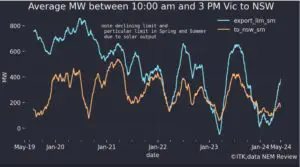Angus Taylor, go to the naughty corner. Terrible policy, terrible process
It’s difficult to make too many detailed comments on the federal government’s proposed legislation on enabling ministerial power to force power station divestment, as the draft legislation has not been publicly circulated.
Rushed, secretive legislation are red flags for democracy and good policy. Every business should fear a ministerial power that allows for complete interference in the private sector.
The policy will be reviewed after the intervention of small “l” Liberal backbenchers, but there are questions as to why this is contemplated at all. Next it will be Newscorp required to divest the Daily Telegraph because Newscorp has too much influence in the media market. Or perhaps the Big Four banks should be required to sell, say, their Queensland operations.
The ACCC is the government body charged with maintaining adequate competition. It is backed up by a court system including a specific Competition Tribunal and appeals can be made from there to the Federal Court.
The current government has already compromised the legal resort of Network owners by removing many of their rights of appeal to the Competition Tribunal.
Many – most – supported the government in this, but it could be argued the fault lay in the 100 year ownership licenses handed to the Network company investors. If those licenses had been for 20-30 years, as happens for say many toll road franchises, it may have been easier to negotiate changes with the network company owners in return for franchise extensions. That’s just a pipe dream now.
The point is the federal government is systematically undermining the basis of the private ownership of the electricity market in Australia. Legal rights are being cut back at every turn.
The federal Opposition also plans to increase its influence in the electricity business, but in our view it is in a far preferable, open and measured way.
Increased funding for the CEFC and funding for an Energy Infrastructure and Security fund act more to nudge the private sector in a particular direction, and arguably facilitate private sector investment. Further, this is done at arms length from the government of the day.
The government provides the money, the CEFC and ESI executive determine how its used. These are the checks and balances that citizens have a right to expect.
ESB/COAG meeting on ISP action
In another example of the government increasing its involvement, we expect the ESB to make proposals about which of the options it supports for progressing the Integrated System Plan.
Enthusiastic readers might recall that back in September the ESB outlined and consulted on five options to make the ISP actionable:
- Transmission providers [TP] decide on transmission investments but are required to consider the ISP;
- TP decide on transmission but must do RIT-T on ISP identified needs;
- AEMO determines “best” option but TP decides how to implement;
- AEMO determines best option and directs TP;
- AEMO determines option including functional specification and directs TP to implement.
Although many might think one of the “AEMO determines” options are best, it won’t surprise if the ESB and particularly John Pierce has anything to do with it that the first two options are at the top of the list.
We expect COAG to consider this in the next week or two, so watch the space.
The market action – low consumption ex QLD
Victorian consumption was down 18 per cent compared to PCP, NSW 6 per cent. Overall, for the calendar year to date, consumption – ignoring behind the meter – was flat, to slightly down.
REC prices fell again.
Spot gas prices continued to be ridiculously strong.


Oil prices fell again. Bond rates bother in Australia, and even in the USA, are now roughly where they were last year, as in fact is the exchange rate.

Base Load Futures, $MWH

Note how the near-term future contracts have risen compared to a year ago in all states. We argue this is partly higher than expected forced outages at coal, partly gas prices, partly reduced hydro availability and partly the slow connection process of new wind and solar to the grid.

Gas Prices











